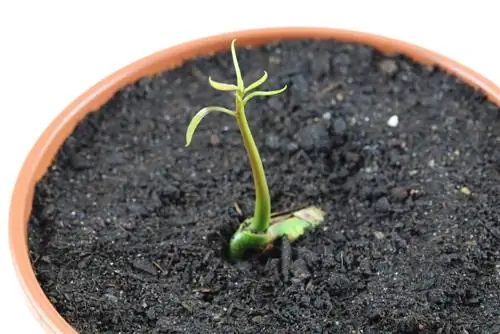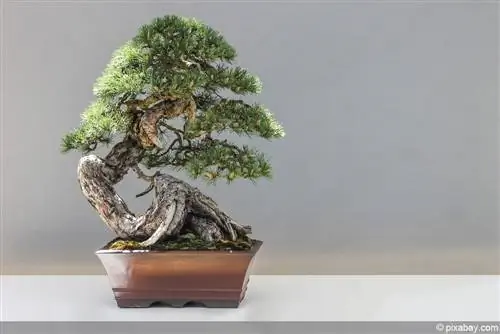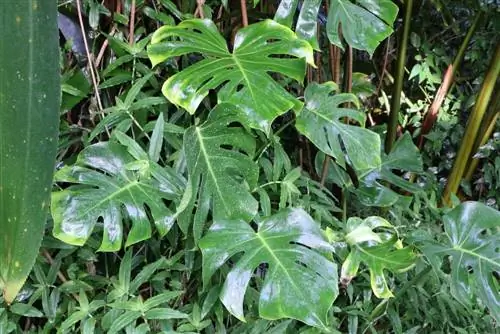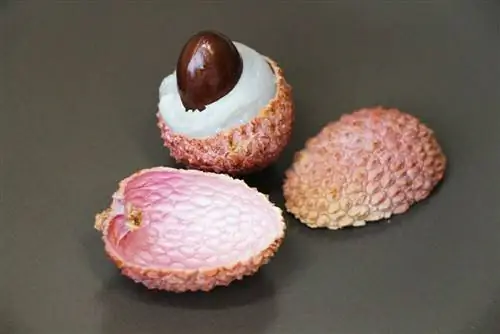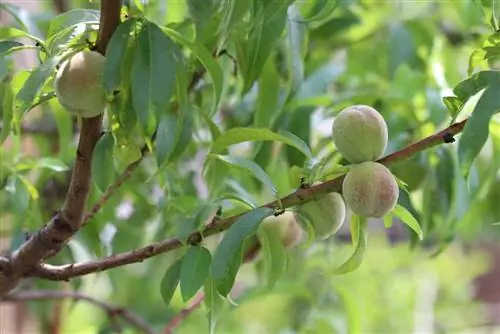- Author admin [email protected].
- Public 2023-12-17 03:39.
- Last modified 2025-01-24 12:45.
If you want to grow trees on your own, you don't always have to purchase a pre-grown specimen. Numerous native species are suitable for exactly this purpose. The seeds that you can take from the fruit are used for this. This project depends on the plants you have available and seeds, as well as tips for growing and caring for them.
Core: Definition
Growing trees can quickly become expensive if specimens are purchased from nurseries. Depending on the size, vintage and variety, prices can vary and sometimes be prohibitive. For this reason, a popular alternative is to grow trees from cores yourself. Since seeds can be found in the fruits, they are ideal for cultivation without incurring high costs. Among the most characteristic species in your own garden are those that belong to the pome and stone fruits. The two groups differ significantly, although some fruits and the trees themselves may appear somewhat similar at first glance. Therefore, it is important to know what constitutes species with nuclei:
- Core housing usually present
- at least 5 chambers
- at least 1 core in each chamber
- Nuclei are the seeds
- Core quite soft
- can be chewed
- no case available
- Seeds and fruits have a long shelf life and can be stored
In comparison, stones are not connected to a core, as only one is formed per fruit. This can either be present completely as a hard and quite large seed or, as in the case of cherries (bot. Prunus genera) and many other species have a shell. This is where the seed is located. For this reason, the term “cherry stone” is incorrect because it is a stone fruit. As for many other species and especially fruit trees, the term core has simply become commonplace. Since plants with seeds and stones do not have the same cultivation requirements, you need to know about suitable taxa. In the next section you will be introduced to suitable trees that can be grown using cores.
Note:
Stone fruit also includes avocados and mangos, which are considered pome fruit in many places. Although a tree can also be grown from the stones, they are not cores because the structure is completely different.
13 suitable plants with seeds
When selecting suitable species whose kernels are suitable for breeding, there are a few available to you. Especially in Central Europe, there are numerous plants that form seeds that you can use for cultivation. What is striking is the number of species that belong to the pome fruit family (Pyrinae) within the rose family (bot. Rosaceae):
- Crabapple (Malus sylvestris)
- Apple (Malus domestica)
- Pears (Pyrus)
- Chinese quince (Chaenomeles sinensis)
- Serviceberry (Sorbus torminalis)
- Pomegranate (Punica granatum)
- Medlar (Mespilus germanica)
- Quince (Cydonia oblonga)
- Sparrow (Sorbus domestica)
- Mountain ash (Sorbus aucuparia)
- Hawthorn (Crataegus)
- Japanese loquat (Eriobotrya japonica)
- Copper rock pear (Amelanchier lamarckii)
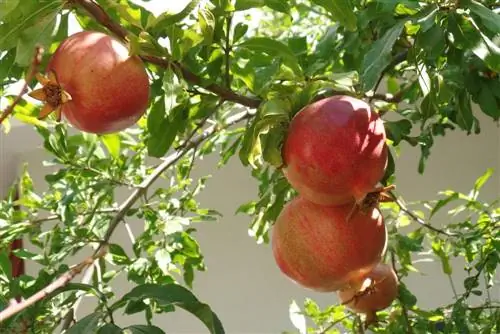
The pomegranate is a big exception here. Pomegranates have an extremely large amount of seeds that can be used for cultivation, while apples or pears, for example, do not have as many available. In species such as mountain ash, on the other hand, the core housing is not as pronounced and the kernels are extremely small. This makes harvesting more difficult. Nevertheless, you can grow a tree from all of the above species. If you specifically want to grow fruit trees, this is a good opportunity.
Note:
The kernels of the species and genera mentioned are often referred to as seeds, especially if they are quite small. Don't let this put you off if you have a specific
Pulling a tree from the core: 7 tips
As already described above, you have to pay attention to a few points in order to be able to grow a vital tree from seeds. If seeds are used for propagation, use robust and undemanding plants that are happy with little. Quite the opposite to stone fruit, because you'll have your hands full with a mango or cherry stone. To make growing using seeds easier for you, you will find 7 tips on this topic in the following sections. Since these species are mostly fruit trees, you can easily apply the information to the species mentioned. If you want to optimally address the needs of the individual taxa, you can also take a look at the portrait or care instructions.
Note:
When using seeds from your own garden, you have to expect that in the end a different variety will be created like the mother tree, which can also have the characteristics of a wild apple. The reason for this is the lack of refinement, which you can make up for later with a scion and a suitable base.
Collect cores
One of the most important points when cultivating your own trees are the seeds. If you already have specimens of the species mentioned in your garden or find them wild in your region, you can easily use the fruits to extract the seeds from them. Maybe your friends or neighbors even have the right tree of the type you want locally. If this is not an option, you can buy fruit from a farmer or organic store. Native varieties are clearly recommended to achieve better results. Depending on the type, variety and size of the fruit, you must expect that a different amount of seeds will be available. They are collected in the following way:
- choose ripe fruits
- open carefully
- don't damage the cores
- Remove cores
- store in bowl
Especially with pomegranates, make sure that the seeds do not fall to the ground. The fruits are well filled. On the other hand, with pomegranates it is not so bad if you damage or lose seeds. In comparison, it is not recommended for an apple or a rowanberry as they do not form as many seeds. Damaged kernels do not germinate.
Tip:
Select the seeds after collecting them so that there are no dead seeds. To do this, the kernels are stored in a water bath overnight and those floating on the surface of the water are disposed of.
Clean
Cores have a big advantage over stones. Since in most cases they are located in a core housing, the cleaning effort before sowing is significantly less. Apple or pear seeds, for example, don't even need to be cleaned. Only species whose seeds are directly covered by the pulp require cleaning. To do this, you let the seeds soak in cold water for a short period of time and then carefully remove the pulp with kitchen paper. Then let the kernels dry. The process is similar to cleaning cherry stones, except that no warm water is necessary.
Encourage germination
Don't forget that many domestic fruit trees need a stimulus to germinate. Above all, a cold stimulus is necessary because it imitates the natural progression of the seasons. This step is not necessary for Mediterranean pome fruits such as pomegranates. These are simply added directly to the growing substrate in spring. This is also the case with the Japanese loquat. Stratification takes place over a period of six to eight weeks and usually begins in December. The clean and dry kernels are placed in a freezer bag with moistened sand. Close tightly and store in the refrigerator, more precisely in the vegetable compartment. The kernels are removed in spring for sowing.
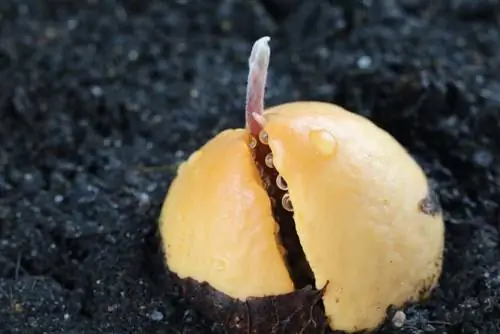
Location
While the location in the garden must have enough space and the right properties, the location for sowing is a little different. The following points should be taken into account when growing fruit trees:
- Light requirement: bright
- no direct midday sun
- Window sill ideal
- warm
- avoid cold drafts
Sowing seeds
As soon as the sowing date for the respective species has arrived, usually in March, you can place the seeds in a suitable substrate. This can be done in the following way:
- Prepare cultivation pots
- Drainage layer at the bottom: gravel, pottery shards
- fill two thirds with potting soil
- Place cores in substrate
- Depth: 0.5 to 2 cm (depending on species)
- moisturize
For some species it is necessary to soak the kernels in water for a period of 24 hours. These include medlars or other trees with a hard core. Don't be surprised: some of the species mentioned take a very long time to germinate. While apples germinate quite early like a cherry stone, you sometimes have to wait until the next year for a plant like the loquat.
Strengthen for planting
As soon as it gets warmer and the sun shows itself more and more, you can accustom the young plants to the outdoors. To do this, the plants in the pot are placed outside for two to three weeks from mid-April to mid-May. Choose a partially shaded location. The plants are brought back into the house overnight, otherwise they will freeze.
Care until planting
The last few weeks until planting or moving into the garden after the Ice Saints are easy. Fertilizer is not necessary, nor do you need to repot. Only the substrate must always be kept slightly moist so that the young plants do not dry out. Nothing more needs to be done until it is time for planting or moving to the outdoor pot. If the plants grow too much, you can shorten the shoot tips a little, for example with pomegranates.

